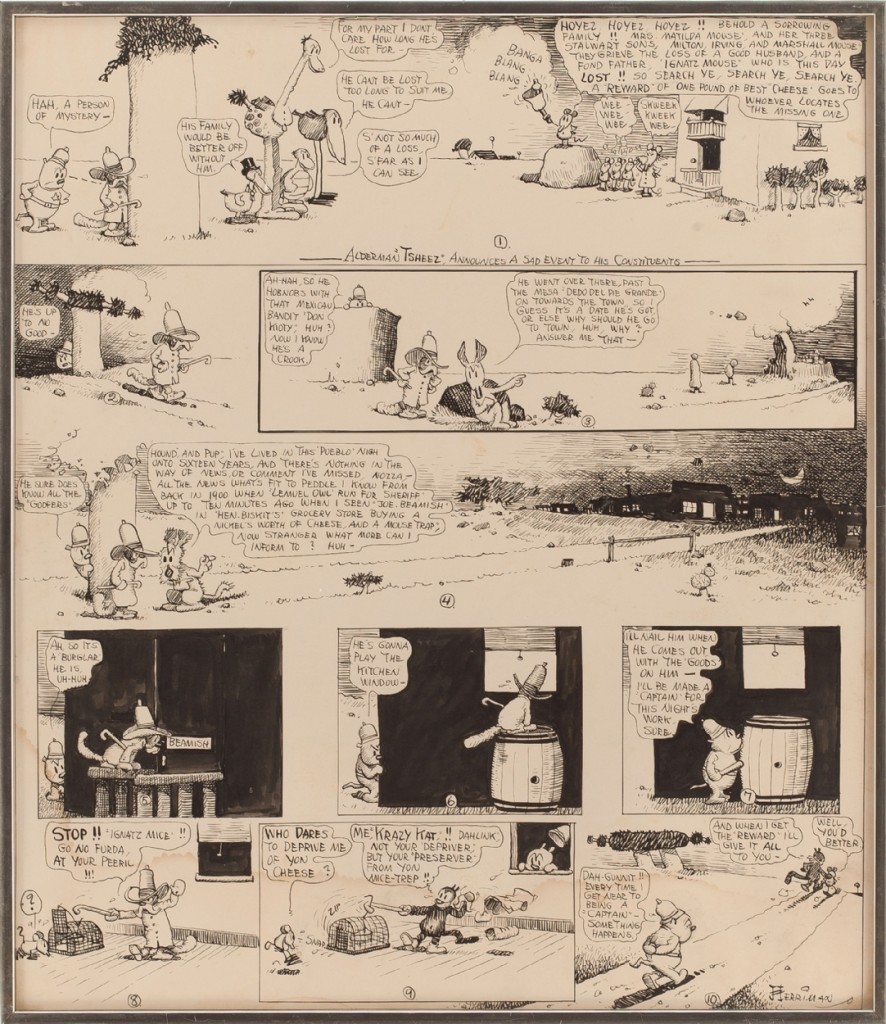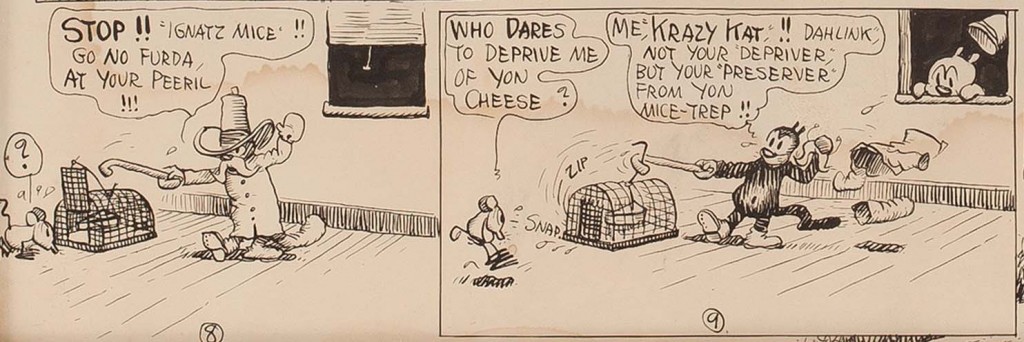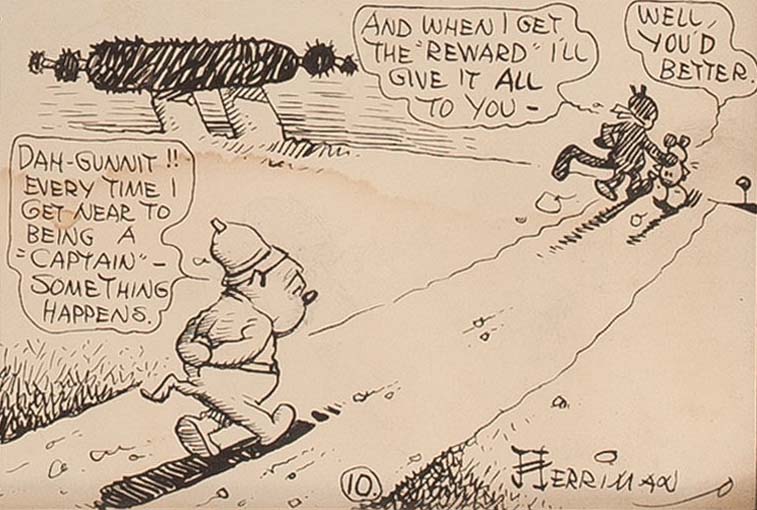“Too much ink has already been spilled on Herriman’s passing for white, and how the strip’s shifting perspectives and mutable characters reflect that decision. And none of it is worthwhile. Doubtless there is a relation, and I’m certain it’s too complex to be formally drawn out and distilled.” [Emphasis mine]
Harry Siegel at the New Partisan
The 16th Krazy Kat Sunday published on 6th August 1916. It has an image area of 18″ by 21.5″ and a water stain marking its lower border.
Background. I’ve been searching for a Krazy Kat Sunday for some time, and I managed to acquire this example only because none of the usual players were interested in it. There are a number of reasons for this. Firstly, there’s the water damage at the bottom of the page which is a minor problem in my book. The other factors are the lack of a brick gag (which I’m not particularly interested in) and the fact that the formal elements in this Sunday are not front and center.
That last point is of importance to me, but this page has other elements which make up for that deficiency. It comes from a period of great creativity for the artist, with some of the most famous episodes crafted during the space of a few years. It is the intricate inking from the early years which I am most fond of: the light touch delineating the characters, and the gentle hatching describing the illuminated night sky above the pueblo. It didn’t take long for Herriman to find his way around the large space of a Sunday page, and here we see him showcasing the wide vistas and deep perspectives so typical of the strip. Most of the major characters are represented here including Joe Stork and Ignatz’s family; all coupled with a constant movement towards the right side of the page. The final panel is a pretty good summary of Herriman’s eternal triangle.
The Plot. Alderman Tsheez is announcing a “sad event to his constituents” who remain determinedly unimpressed if not hostile — the disappearance of Ignatz Mouse (here enjoined by the multifarious sorrow of his wife and children). A mercenary with a walking cane and ten gallon hat listens to all of this and is soon traversing the canyons and mesas of Coconino county. The reward if he succeeds is a pound of the best cheese. His cooperative guide is a “Mexican bandit” called Don Kioty; the quest which the soldier of fortune is about to undertake will take on the color of that guide’s name. The bandit points him towards the Mesa Dedo del Pie Grande which lies in the distance like a stubborn windmill; a big stub of a toe scratching the vault of the sky, and a distant cousin of the oppressive thumb which presses firmly down on Krazy in the Sunday of 2nd December 1917.
His ultimate destination is a land of humor and fear. There is a darkness on the horizon, and it is the process of enveloping the pueblo he has to visit to complete his mission.
George Herriman, so we’ve been told on numerous occassions, always wore a hat when he went out.
The better to hide the curled locks of his “mixed” heritage. A man in disguise just as his much beloved kat is in disguise in this Sunday. Krazy’s mask is a polished beard and a crumpled tail covering his/her ebon caudal appendage, now all burnished white. A cane — a comedienne’s aid — is held firmly in his hand; the tool by which she will make that connection with her desired audience both in the happy end we see on the final panel of this Sunday and the deployment of Herriman’s craft.
The mouse from whom she desires love and affection is a rascal; always mean, treacherous, and selfish in the pursuit of his own ends. The periodic beaning of the kat’s head is unambiguous to all but the love struck feline; the crowd of disgruntled onlookers in the first expansive panel is a chorus announcing the only possible diagnosis when it comes to their relationship. Offissa Pup never suspects, half in love yet always on guard; the tenacious attendant of a system of denigration — the very well from which the kat and her master derive sustenance on a daily basis.
The harsh desert glare which opens this chapter is in stark contrast to the night enveloping the pueblo on the third tier of this page. The walls of Joe Beamish’s store on the next line show a progression from watery shadows in the first instance to fuliginous night in the last, quite perceptible in the original if not on the printed sheet. The moment of confrontation is anticipated with relish by the offissa with his truncheon, and there is an evocation of tenebrosity in his words (“I’ll be made a Captain for this night’s work sure.”)
It is a forbidden place of dangerous transaction; a cage with an irresistible bait, easily resisted with the “crutch” of Herriman’s artistry and craftsmanship.
And then, that persistent dream of a safe and blissful conclusion…
…seen once again in this panel of solemn pining from 1917…
…never to be resolved even at the very end, the kat fading quietly into the arms of time and its inquisitions.
NOTE: Some images taken from the collection of Rob Stolzer.









Revelatory.
Congrats on acquiring a REAL Krazy Kat Sunday strip!
Weirdly, Krazy Kat actually deserves all the overhype it gets! Fantastic.
Thanx, Ng Suat Tong for another worthwhile article!
Congrats Suat!
What a beautiful page. Nice acquisition!
Suat, do you know this wonderful online archive?
http://www.comicstriplibrary.org/browse/results?character=1